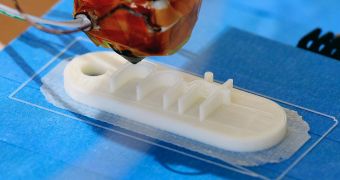Engineers at the Massachusetts Institute of Technology (MIT) really outdid themselves this time. They managed to create an advanced three-dimensional printer capable of building numerous structures from scratch, in a fairly limited amount of time.
MIT pioneered the field of 3D printers, which is currently growing very fast, with numerous research teams involved in producing the most complex machine out there. There is a lot of promise in this area of study, such as the ability to print entire houses or complex mechanical devices, in addition to food.
Analysts are even talking about the advent of the era of mass customization, in which people would provide their inputs on how they want their products to look like, and the 3D printers (3DP) would conform to the smallest detail.
At this point, there are numerous types and variants of 3DP devices in existence, but MIT experts are hard at work towards creating even more complex ones. The latest such effort saw the creation of a device that can be used to print concrete.
Theoretically, a 3D printer can use powders and liquids to create ceramics, metals, plastics and other similar materials. In the new effort, experts are asking whether it's possible to create concrete as well.
The answer – thus far – appears to be positive, which is remarkable news. Just imagine the prospect of being able to build a brand-new house (according to exact, personalized specification) via a giant machine laying down layer upon layer of material without rest.
This new system is currently being developed by the MIT Media Lab Sony Corporation Career Development assistant professor of media arts and sciences, Neri Oxman, PhD. She is working together with graduate student Steven Keating on developing the building-printing technology.
According to Oxman, such printers would be able to produce buildings in shapes that are currently impossible to construct due to the limitations posed by standard wooden molds used in construction.
What is even more remarkable, the very nature of the machine could allow for constant variations in the very nature of the material. The team already managed to emulate the structure of the human bone in concrete cylinders produced by their machine.
Rather than pouring concrete of the same density, the measure varies from high at the rim to low in the center, just like in bones. This gives the material increased resistance to adversity, and provides another selling point for the printer.
“Nature always uses graded materials. [Bones are made up of] a hard, dense outer shell, and an interior of spongy material. It gives you a high strength-to-weight ratio. You don’t see that in man-made materials,” the team leader concludes.
Video description: See MIT's 3D printers in action. Video credit: MIT News Office

 14 DAY TRIAL //
14 DAY TRIAL //